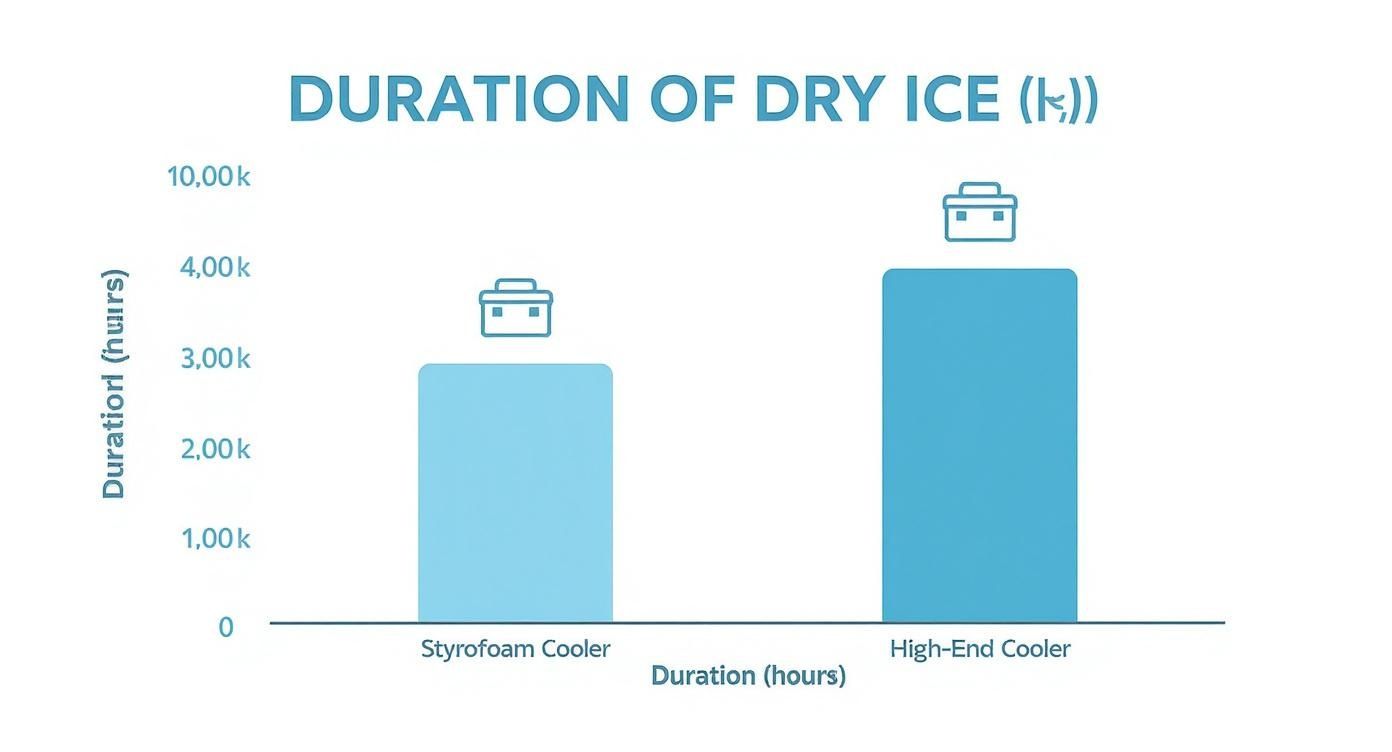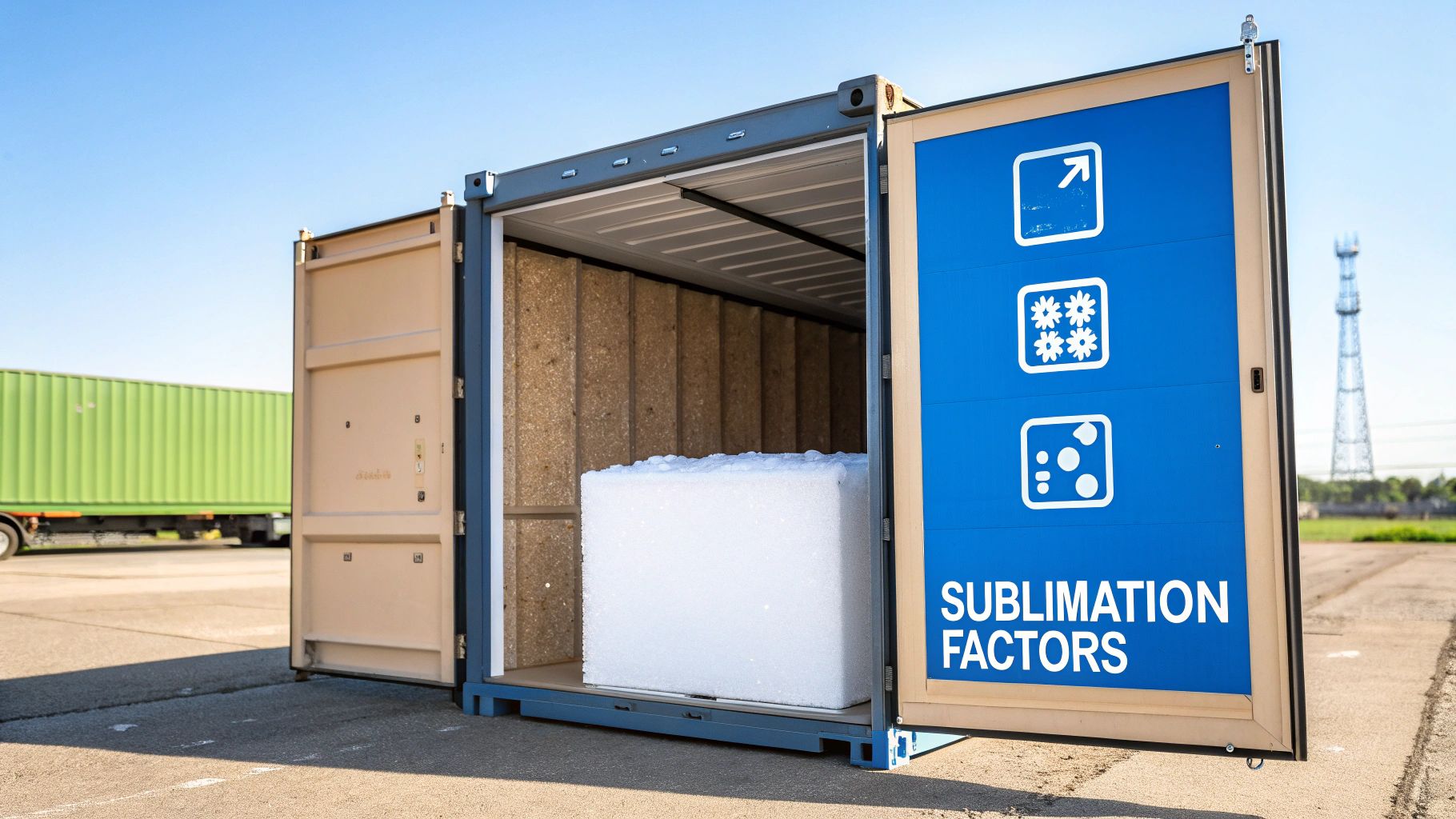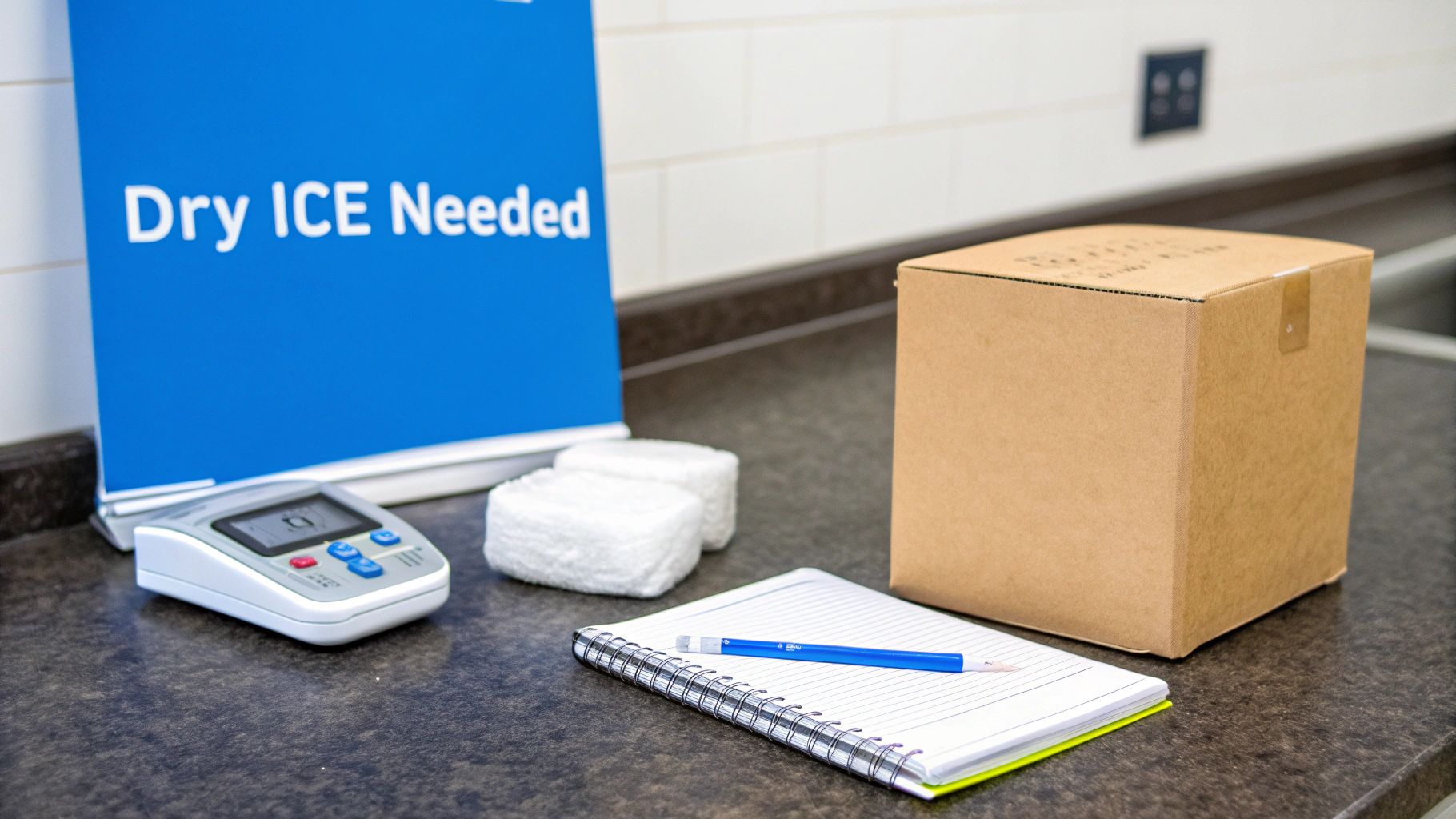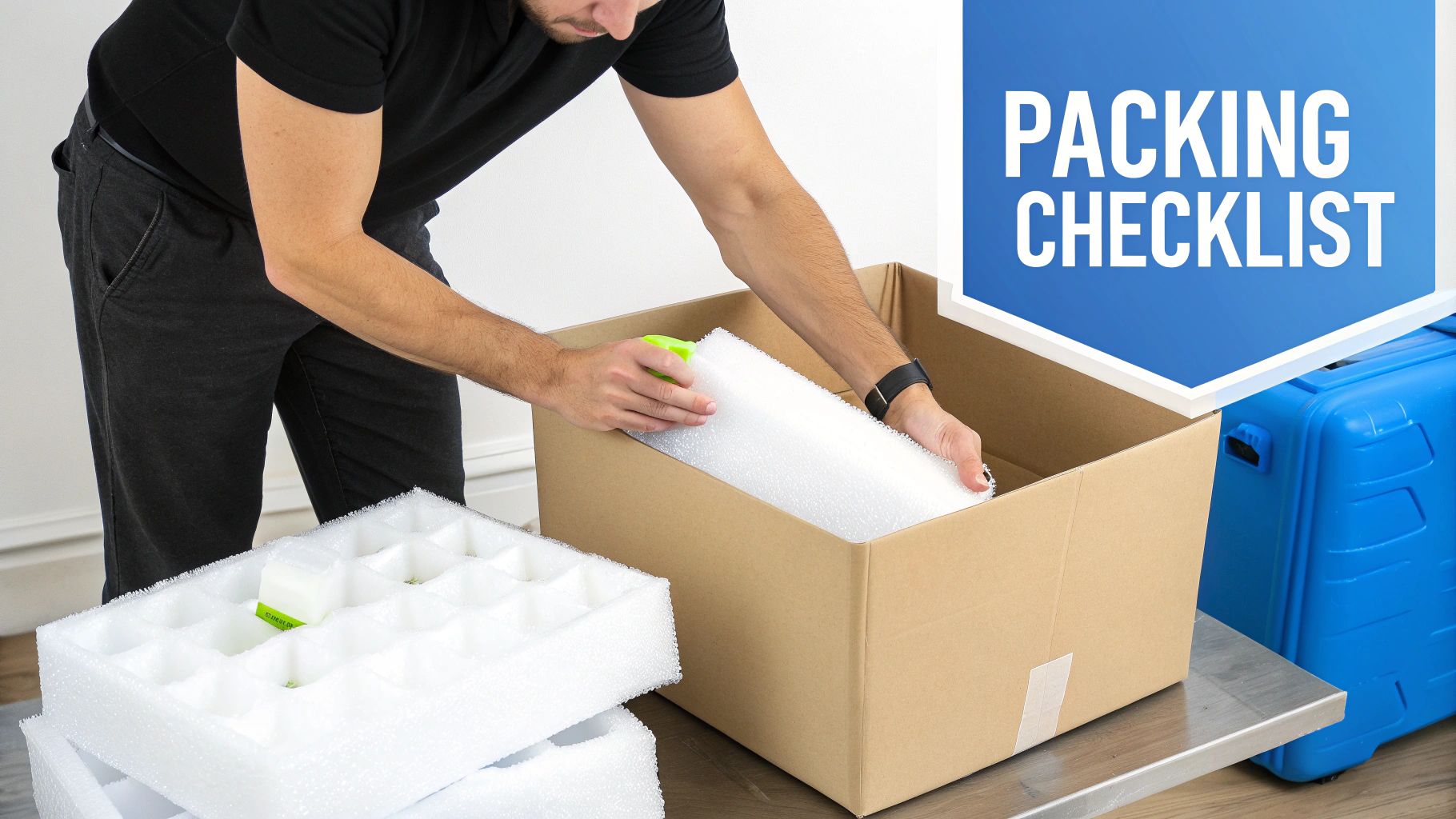Here's the simple truth: 5 to 10 pounds of dry ice will typically last for 24 hours in a standard insulated shipping container. But that's just a baseline. The actual duration depends heavily on the quality of your container, how much dry ice you use, and even the weather during transit.
When you're shipping perishable goods, knowing how long dry ice lasts isn't just a detail—it's the critical factor determining whether your products arrive in perfect condition or as a spoiled mess. The longevity of dry ice is a moving target, but with the right information, you can make a solid estimate.
Think of an insulated shipping box as a fortress defending against its enemy: heat. A basic Styrofoam cooler is like a wooden fence, offering minimal protection. In contrast, a high-end, vacuum-insulated container is like a stone castle, holding off the heat for much longer.
This difference in insulation quality is the single most significant factor in how long your dry ice will survive its journey.
The type of container you choose will drastically change how long your dry ice lasts. While a simple cooler might get you 18-24 hours, a high-performance shipper can extend that to several days by minimizing how quickly the dry ice turns to gas (a process called sublimation).
For example, a standard Styrofoam cooler can lose 30-50% of its dry ice per day, especially with smaller quantities. You can dig deeper into the science behind these rates to understand what's happening inside the box.
The chart below gives you a quick visual comparison of how a basic cooler stacks up against a high-end insulated shipper.

As you can see, investing in a better-quality container can easily double the effective lifespan of your dry ice. This provides a crucial buffer against unexpected shipping delays. Knowing these variables is key, but you also need to factor in the total time your package will be in transit. Our guide on calculating shipping lead time can help you create a more accurate timeline for your shipments.
To help you plan, here's a quick-reference table that brings all these estimates together.
This table gives you a practical look at how long different amounts of dry ice might last in common types of shipping containers. These are real-world estimates, not guarantees, but they provide a solid starting point for your planning.
Remember, these numbers can shift based on how full the container is, the outside temperature, and how many times the box is opened. Always err on the side of using a little more dry ice than you think you'll need, especially for critical shipments.
To really get a handle on how long dry ice lasts for shipping, you first have to understand its unique disappearing act. We’re all used to regular water ice, which melts into a puddle. Dry ice, on the other hand, plays by a completely different set of rules.
Dry ice is simply the solid form of carbon dioxide, frozen to an incredibly frigid -109.3°F (-78.5°C). Instead of melting, it undergoes a process called sublimation. Think of it like a block of ice that just vanishes into thin air, leaving no messy liquid behind. This magical transformation is the secret to its cooling power.
As dry ice turns from a solid block directly into carbon dioxide gas, it absorbs a massive amount of heat from its surroundings. This constant heat absorption is what keeps products deeply frozen during their journey.
So, the whole challenge of shipping with dry ice isn’t about stopping it from melting—that's impossible. It's about slowing down how quickly it vanishes.
The core of effective dry ice shipping isn't just about how cold it starts, but about strategically managing the rate at which it converts to gas. Every packing decision you make either accelerates or slows this inevitable process.
Understanding sublimation is the "why" behind every best practice in dry ice shipping. If your sublimation rate is too fast, your cooling power runs out quicker, putting your shipment at risk. A slower, more controlled rate extends the life of the dry ice, giving you a crucial buffer against unexpected shipping delays.
Several key factors directly influence how quickly your dry ice disappears, and we’ll dive into these next:
Mastering how these elements work together is the secret to ensuring your products arrive perfectly frozen, every single time. It turns packing from simple guesswork into a calculated science, letting you reliably predict just how long your dry ice will last on its journey.

Ever wonder why one shipment arrives perfectly frozen while another shows up thawed? It's not luck. The answer is in managing the four key variables that dictate how fast dry ice turns back into a gas.
Think of it as a race against time, and you're in control of the clock. By understanding these factors, you can turn a risky shipment into a reliable delivery. Each one plays a critical role in preserving the cold, and ignoring even one can lead to a costly, melted mess. Let's break them down.
Your shipping container is your number one defense against heat. A cheap, thin-walled styrofoam cooler is like wearing a light jacket in a blizzard—it offers a little protection, but it’s not going to hold up for long. Heat from the outside world will slice right through weak insulation, causing the dry ice to disappear much faster.
A high-quality, thick-walled insulated shipper with a snug lid, on the other hand, is like a modern arctic parka. It creates a powerful thermal barrier that dramatically slows down heat transfer. This one upgrade can easily double the life of your dry ice, making it the single most important investment for reliable cold shipping. The same principle applies to massive facilities, which you can learn more about in our guide to cold storage warehouse requirements.
It's not just how much dry ice you use, but what shape it's in. A larger, denser mass of dry ice has less surface area compared to its volume, which means it sublimates more slowly.
Think of it like building a campfire. A single large log will burn for hours, but a handful of twigs with the same total weight will be gone in minutes. The same logic applies here. A 10-pound solid block of dry ice will last significantly longer than 10 pounds of tiny pellets. The pellets have way more surface area exposed to the air, causing them to vanish much more quickly.
The environment your package travels through is a huge, uncontrollable factor. A box moving through Phoenix in July faces a much bigger challenge than one traveling across Alaska in January. The higher the outside temperature, the harder your insulation has to work to protect the dry ice inside.
A shipment's journey is rarely a straight line through a perfectly climate-controlled world. Your package could be sitting on a scorching hot tarmac, baking in a non-refrigerated truck, or sitting in a sunny spot at a distribution center—all of which accelerate sublimation.
Always plan for the worst-case temperature scenario on your shipping route. For a better sense of how critical temperature control is across the cold chain, it's helpful to understand the recommended temperatures for commercial freezers.
Empty space inside your shipping box is the secret enemy of cold shipping. Air circulation is a major catalyst for sublimation. When there's a lot of open room, air moves freely, transferring heat to the dry ice from all sides and speeding up its conversion to gas.
The fix is simple: fill all the voids. Use dunnage like crumpled paper, foam inserts, or bubble wrap to pack the box tightly. This easy step traps air, reduces circulation, and dramatically slows the sublimation rate. A tightly packed box is a happy, and much colder, box.
Guessing how much dry ice you need for a shipment is a recipe for disaster. Winging it might seem fine for a quick local delivery, but it’s a huge gamble for anything traveling overnight or across the country. Get it wrong, and you’re looking at spoiled products and wasted money.
Fortunately, there’s a reliable way to get it right. The industry standard gives us a solid starting point: plan for 5 to 10 pounds of dry ice for every 24-hour period your package will be in transit. Think of this as the foundation for a successful cold chain, but it's a baseline that almost always needs a few tweaks.
One of the biggest mistakes shippers make is calculating the exact amount of dry ice for the estimated transit time and calling it a day. A "two-day" shipment can easily stretch into three days because of weather, mechanical issues, or a delay at a sorting center. It happens all the time.
Always add enough dry ice for an extra 24 hours. This simple buffer is your insurance policy against the unpredictability of shipping logistics. If your shipment is scheduled for 48 hours, pack enough for 72.
This one proactive step is what separates the pros from the amateurs. It’s an acknowledgment that delays are part of the game and ensures your product’s integrity isn’t on the line because of something you can't control.
That 5-10 pound rule isn't a one-size-fits-all solution. The type of product you're shipping plays a massive role in how much dry ice you should use.

The main goal is to maintain a consistent, deep-freeze environment inside that box. Industry best practices often suggest that 5-10 pounds of dry ice per day is sufficient for product weights up to about 12.5 pounds, as this amount safely counteracts the typical sublimation rate. As you can see in these temperature group guidelines, international shipments often demand even more planning, with a minimum of 20 pounds just for a two-day trip to account for potential customs hold-ups.
To make your life a bit easier, here’s a quick reference table. It provides some solid estimates based on common shipping scenarios and package sizes. These numbers assume you're using a quality insulated shipper, so adjust accordingly if your container is less efficient.
Always remember to cross-reference these estimates with your package's actual weight and the sensitivity of what’s inside. This kind of structured approach takes the guesswork out of the equation and helps you build a much more resilient cold chain.

You can run the numbers perfectly and calculate the exact amount of dry ice you need, but it won't matter one bit if the box is packed poorly. How you pack your container is just as crucial as how much dry ice you use. A shoddy packing job can sabotage your entire shipment, dramatically cutting down how long the dry ice lasts.
Think of it like this: the dry ice is the engine keeping your shipment cold, but your packing method is its fuel efficiency. A well-packed box conserves every bit of cooling power, making sure it lasts the whole journey. By following a few key principles, you can create a secure, efficient, and safe environment for your temperature-sensitive products.
The laws of physics are your best friend here. Cold air is denser than warm air, which means it sinks. This simple scientific fact dictates the single most important rule for packing with dry ice.
Always place the dry ice on top of the products you want to keep frozen. As the dry ice sublimates, that super-cold CO2 gas will flow downwards, blanketing your items in a consistent layer of frigid air.
Once your items are in the box with the dry ice layered on top, your next mission is to eliminate empty space. Air is the enemy of cold retention. Any voids inside the box allow air to circulate, which rapidly accelerates sublimation and wastes precious cooling power.
Understanding the finer points of safe packaging is a must, and our complete guide to shipping food with dry ice provides expert tips on everything from packaging to proper labeling.
This is the golden rule, the one you absolutely cannot ignore: never, ever use an airtight container. It feels counterintuitive—don't you want to trap the cold air in? No, and sealing the box is incredibly dangerous.
As dry ice turns from a solid to a gas, it expands to a massive volume. If that carbon dioxide gas has no way to escape, pressure will build inside the container until it ruptures or even explodes. This creates a serious safety hazard for anyone handling the package and could completely destroy your shipment.
Your insulated container must allow this gas to vent. Proper shipping boxes designed for dry ice have small perforations built in for this very reason. If you're using a standard cooler, make sure the lid isn't latched airtight. A small vent is mandatory for a safe shipment.
While mastering dry ice packing is a unique skill, for other valuable items, bringing in professional packing services can ensure everything is handled with expert care. Follow these practices, and you'll turn a simple box into a high-performance cold-chain machine.
Shipping with dry ice isn’t as simple as taping up a box and handing it over. All the major carriers—FedEx, UPS, and USPS—have strict, non-negotiable rules you have to follow. This isn't just red tape; it's a serious safety issue for every single person who handles your package along its journey.
Because dry ice sublimates into carbon dioxide gas, it's officially classified as a hazardous material (or "dangerous goods"). In an enclosed space like a truck or cargo hold, that CO2 gas can displace oxygen, creating a hazardous environment. This is why you can't just ship it without telling anyone. Following the rules is the only way to keep your package from being rejected, delayed, or even destroyed.
Getting the labels right is probably the most critical part of shipping dry ice. You have to clearly and correctly communicate what’s inside the box.
Every single dry ice shipment needs these specific markings:
Messing up these labels is the fastest way to get your shipment stopped in its tracks. Because it's a regulated hazardous material, these labels and quantity controls directly impact everything from product shelf life to global cold chain safety.
Always declare the dry ice to your carrier. Trying to hide it is a serious violation of federal regulations and carrier policies, and it puts transport workers at real risk.
While the core rules for labeling are consistent, each carrier has its own specific quirks, especially when it comes to weight limits and required paperwork.
For instance, airlines are much stricter about how much dry ice can go in a single package. The limit for air shipments is often around 5.5 pounds (2.5 kg) because of the pressure changes that happen in a plane's cargo hold.
Ground shipping, on the other hand, usually allows for much heavier quantities of dry ice, but you still need all the proper labels and documentation. Before you even think about packing, your first step should always be to check the latest guidelines from your specific carrier. To get a better handle on the broader regulations, you can start by mastering hazmat shipping requirements in our detailed guide. Getting these rules right the first time ensures your package gets where it's going without any expensive headaches.
Even with the best plan, you're bound to have a few questions pop up when you're getting a dry ice shipment ready. Getting these right is the key to avoiding expensive mistakes and making sure your package shows up perfectly frozen. Let's dig into the most common questions we hear from shippers.
Absolutely not. If you remember one thing, make it this: never, ever seal a container with dry ice inside.
Dry ice doesn't melt; it sublimates, turning directly from a solid into a massive volume of carbon dioxide gas. If that gas has nowhere to go, pressure builds up fast. This can cause your package to swell, rupture, or even explode, which is a serious safety hazard for everyone handling it.
Your shipping container needs to be well-insulated, but it must also allow the gas to vent. Proper boxes designed for dry ice shipping already have small, built-in vents for this exact reason. Never tape a cooler shut or use any kind of airtight container.
This is a great question, and the answer really depends on what you're shipping and for how long. Both have their place, but for most shipments—especially anything traveling for more than a day—solid blocks are going to be your best bet.
A single, large block of dry ice has way less surface area than the same weight in pellets. With less surface exposed to the air, it sublimates much more slowly, giving you longer-lasting and more reliable cooling power for the journey.
Pellets are fantastic, though, for filling in odd-shaped gaps around your products. They get into all the nooks and crannies to ensure everything is cooled evenly, but just know they'll disappear much faster than a solid block will.
If all the dry ice sublimates before your package gets where it's going, the temperature inside the box will start climbing to match the outside air. For frozen goods, that means they're going to start thawing out.
Depending on how sensitive your product is and how long it sits without cooling, this can quickly lead to spoilage. That's precisely why it's so important to calculate how much dry ice you need for the trip and always add a 24-hour buffer to cover any unexpected carrier delays.
Navigating the world of temperature-controlled shipping can be a major headache for growing brands. Simpl Fulfillment specializes in exactly these kinds of challenges, offering expert 3PL services for everything from frozen food to regulated materials. Let us handle the logistics so you can get back to focusing on your business. Discover how Simpl Fulfillment can streamline your operations.